Ground Source Heat Pump Installation Guide
Ground source heat pumps utilise natural heat accumulated underground, in order to provide heat within a building.
Ground source heat pumps can offer various benefits.
These types of pumps are becoming more popular as they are reliable and highly environmentally friendly, not to mention the energy cost savings one can benefit from.
But what should you know before a ground source heat pump installation?
We discuss key aspects relating to ground source heat pump installation in more detail below.
Article Chapters
What is a Ground Source Heat Pump?
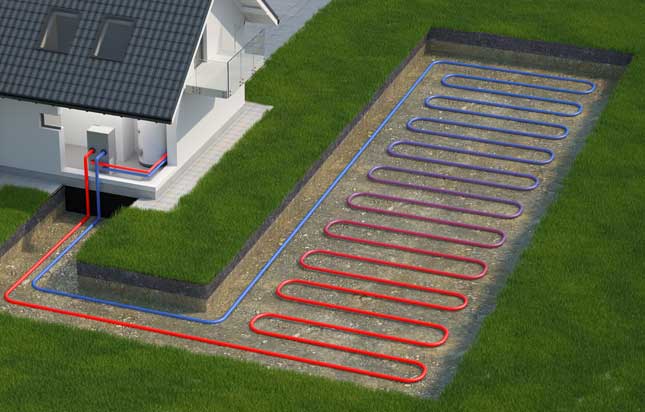
Image credit: Shutterstock
Ground source heat pumps extract energy from the ground, and then via compression transfer around four times more energy to the property in the form of heat.
While they still need electricity to run, they use comparatively far less energy than the heat they produce.
Ground source heat pumps are energy efficient and environmentally friendly since they help to reduce your carbon footprint, whilst also lower your energy consumption.
While traditional central heating systems have to burn fossil fuels in order to generate heat, a ground source heat pump only uses electricity in order to extract heat from the ground to the compressor.
To achieve this, a network of pipework is buried in the ground.
These pipes are filled with a refrigerant which extracts heat.
This is then passed through the compressor located within the heat pump to increase its temperature.
This is then transferred for use as central heating as well as heating water.
Why Install a Ground Source Heat Pump?
As already noted, ground source heat pumps offer a myriad of advantages.
However, you will need to consider whether such a heat pump is suitable for your property.
If you’re looking for ways to create a more sustainable home, then a ground source heat pump is a great option.
Inevitably installation costs will always be a key consideration, as well as long term return on investment.
The initial expense required to install a ground source heat pump may seem quite substantial.
However, you should also bear in mind that there are government grants you could benefit from.
You need to remember that a well designed ground source heat pump can be four times more efficient than a gas boiler.
Hence running costs will be significantly lower.
Inevitably you will need to factor in heat pump maintenance costs that will be required from time to time.
But overall, investing in a ground source heat pump can prove to be good for both your pocket as well as the environment.
What Does a Ground Source Heat Pump Look Like?
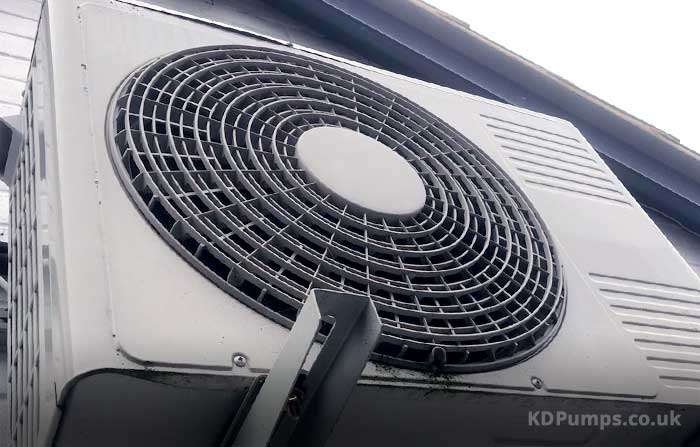
Image credit: KD Pumps
While such a system uses energy from outside the premises, the heat pump itself is actually installed inside the building, just as a traditional boiler would.
The heat pump itself is designed to fit a small space.
It can sit in a kitchen cupboard, under the stairs or in a utility room.
These pumps are quite compact and they do not make too much noise.
How Does a Ground Source Heat Pump Work?
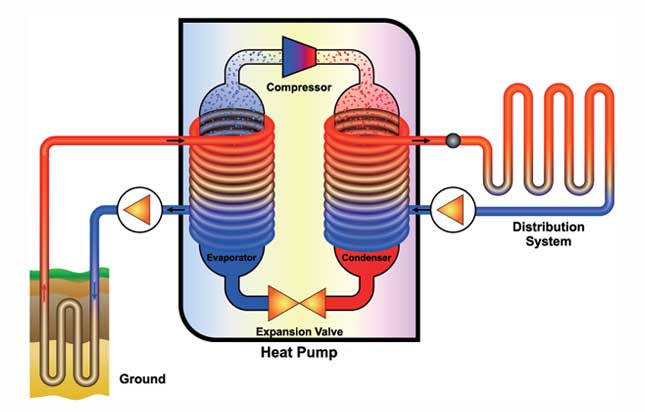
Image credit: Shutterstock
Heat flows naturally from warmer to cooler places.
A ground source heat pump exploits this principle by circulating a refrigerant through an array of pipework set in the ground.
Low-grade surrounding energy is absorbed from such external heat sources.
The heat pump then compresses and condenses such energy so that it reaches a higher temperature.
This is then transmitted to the property’s central heating system, as well as the hot water system.
The fluid then continues its circuit back to the pipework underground so that the cycle starts all over again.
The location and the design of the loop is a key consideration of such a system.
Ground Loops vs Boreholes
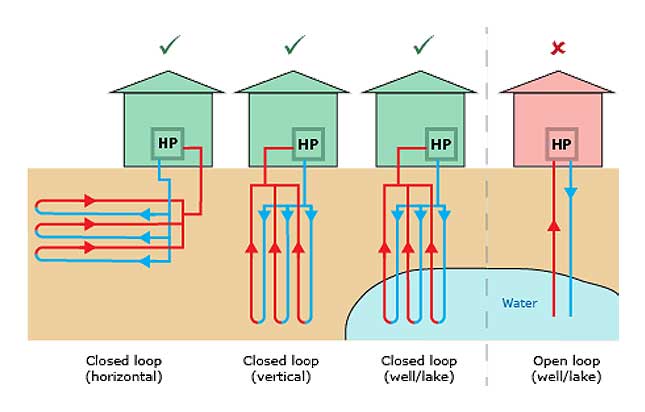
Image credit: New South Wales Government
In the case of horizontal or ground loop systems, the excavation will entail creating shallow trenches in which polyethylene pipes will be laid at a depth of between 1 to 2 metres.
Horizontal installations are often cheaper and only need about half an acre of land.
However they are not always possible.
In fact, if space is limited, one will need to consider whether it’s still practical to install a ground source heat pump by opting for a vertical loop system instead.
In this case, boreholes will need to be dug by using drilling rigs.
Depths will range from 15 to 120 metres deep.
Obviously this will be far more expensive to carry out, considering the extensive groundwork involved.
However, the ground temperatures are much more stable the deeper the loop is.
So as a result, the heat collection efficiency of such a system is much higher.
Benefits of a Ground Source Heat Pump
The following are some of the main benefits of installing a ground source heat pump:
- Low carbon emissions, helping to reduce your carbon footprint
- Takes advantage of a free source of heat from the ground, since the heat pump absorbs solar energy from various natural resources.
- High efficiency of 400%
- Cheaper energy bills; compared to oil or LPG one can expect to save considerably on heating bills, with the possibility of saving between 30% and 50%
- This is a renewable heating option, which is being incentivised by governments.
- A practical option, which does not require much maintenance or servicing
- Low running costs.
- Not susceptible to fuel price changes or energy security threats.
- Safe option as there is no fire risk, unlike when one uses fuel sources.
- Low noise levels.
- Ground source heat pumps can be used in conjunction with other types of renewable technology to further improve efficiency and reduce costs.
Who Usually Installs a Ground Source Heat Pump?
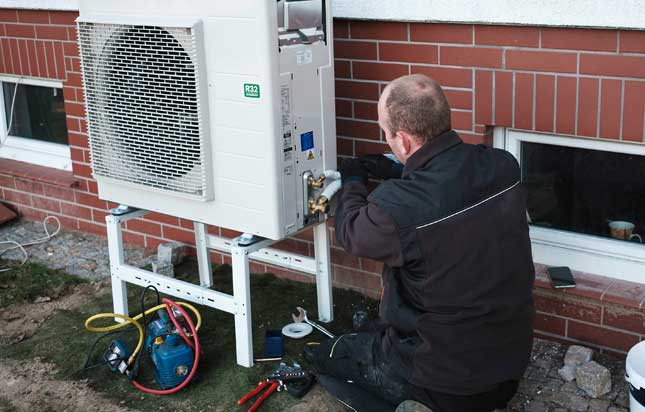
Image credit: Shutterstock
While ground source heat pumps can lead to various benefits, they are not recommended for all households.
Here are some things you should take into account:
Size of Property
In order to install a ground source heat pump, you will need to have a sufficient amount of outdoor space which is able to support the ground loop and the pump.
Installation also calls for access to digging machinery, and so each case will need to be discussed with a professional heat pump installer to evaluate your particular circumstances.
Current Fuel System
You will be able to save more money if you are going to replace an old or considerably expensive heating system, such as electric heating or LPG.
On the other hand, if your existing fuel system is one that is connected to mains gas, the savings will not be as high.
Insulation
You should focus on improving your home’s overall energy efficiency with other methods, such as loft and cavity wall insulation.
Water Heating
If you also want to generate water heating from the heat pump, you may need to have a separate electric immersion heater for best results.
It is imperative to consult with a qualified and experienced contractor who will be able to advise on the most suitable ground source heat pump system, as well as take care of the installation professionally.
How Much Does a Ground Source Heat Pump Installation Cost?
Ground source heat pumps installation costs vary considerably as there are a number of factors that come into play.
First of all it depends on whether you will need boreholes or ground loops, as outlined above.
The choice will depend on the ground conditions, and the space that you have available.
The ground source heat pump will cost around £10,000.
In the case of a ground loop installation, the cost is generally of around £4000.
On the other hand, vertical groundwork cost tends to run somewhere in the range of £8,000 and £18,000.
Indeed, there is a considerable difference in the groundwork costs that come along with a horizontal versus a vertical ground loop system.
Vertical groundwork will cost at least twice as much as horizontal groundwork.
The heat pump capacity will also have an impact on the cost.
This will depend on the number of rooms that need to be heated too.
One will also need to take into account that the more well insulated a house is, the less expensive it will be to install a ground source heat pump.
However, whilst the purchase and installation cost of a ground source heat pump may look to be relatively high, it’s recommended that one is not put off by this as the cost savings longer term run can pay off in time.
Moreover, you may qualify for a £6000 grant offered by the UK government, namely the Boiler Upgrade Scheme.
So you will be able to save a hefty sum, making it a more affordable option.
This grant is aimed at existing properties, as the main objective is to encourage homeowners to make the switch from fossil fuel boilers to heat pumps that are much more environmentally friendly.
How Long Does a Ground Source Heat Pump Installation Take?
The installation process will vary according to the complexity of the system and the type of excavation works required.
Generally, the excavation process will take between one to two days.
In case the old heat distribution infrastructure is going to be replaced with a new one, such as to install underfloor heating, one will also need to factor in two to four days to complete.
What Will the Ground Source Heat Pump Installer Do?
Your professional heat pump installer should be selected carefully.
They should be a trustworthy, licensed and insured contractor who is able to offer a reliable installation service.
Check the after care warranty they offer and that they’re able to offer a maintenance contract.
They should also be MCS approved.
The installer should start off with a thorough survey of the property.
This is to evaluate the requirements of the heat pump that will be installed, based on heating requirements and property size.
The space available will need to be checked, as well as the soil.
This will then lead to the design and planning of an adequate ground source heat pump system for the property.
The installer will also advise and oversee the required excavation works.
Is a Ground Source Heat Pump Practical For My Home?
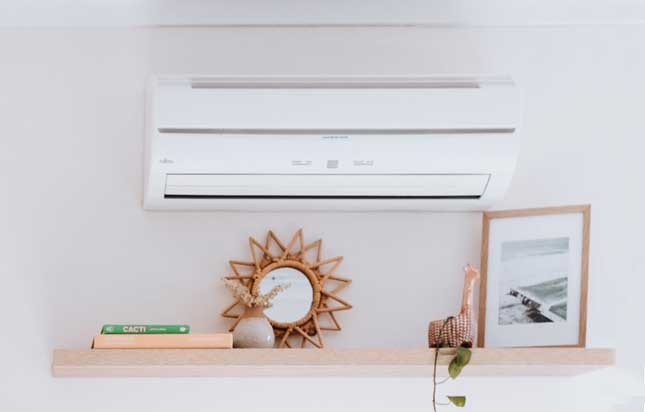
Image credit: Pexels
As mentioned earlier, while ground source heat pumps are undeniably eco friendly and can lead to considerable cost savings, they are not the ideal option for every property.
One of the main considerations is whether you have enough space in your garden or backyard to have a horizontal array installed.
If not, it may be practical to opt for a borehole installation or an air source heat pump installation instead.
Insulation is another key factor to consider.
If your home is well insulated, then you will be able to achieve better results when installing a ground source heat pump.
If not, you should first seriously consider insulating your home first to the highest possible degree, especially if your home has higher heating demands.
In such a case you will need to invest in a much larger system, which is obviously going to be more expensive to buy and to install, as well as to run.
Hence, the importance of substantiating such an investment with good insulation practices.
The type of heating system that you have at home should also be considered.
As ground source heat pumps produce low temperature heat when compared with other options, underfloor heating is considered to be the best choice to work with such a heating system.
Ground Source Heat Pump Installation Process
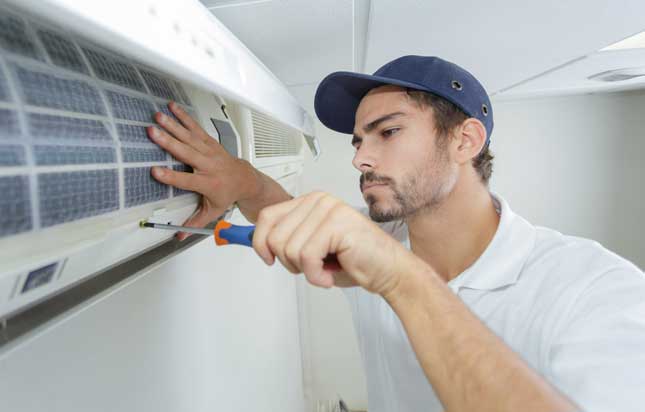
Image credit: Shutterstock
Property Inspection
The installer will start by surveying the property to ascertain the most suitable heat pump system.
The installer will appraise the energy distribution that is most adequate, the hot water requirements, any existing exchanger and heating systems, as well as the current standard of insulation in the property.
The installer will also check the geology and the hydrology of the soil.
Following such an appraisal, the installer will then be able to draw up a building heat load analysis and proceed in planning and designing a suitable ground source heat pump system for that property.
Groundwork & Excavation
The excavation process will then need to be carried out.
This could be horizontal or vertical loop fields, where the pipes shall then be buried underground.
As previously explained, with a horizontal excavation the process is simpler and more affordable than with a vertical loop system.
Pipework Installation
The installation of the pipes will then take place.
These will then be filled with a mixture of water and an antifreeze solution to act as a heat exchanger.
Any modifications to the ductwork will be carried out if necessary, such as if the old heat distribution infrastructure needs to be replaced with a new one.
Underfloor heating works best with a ground source heat pump system.
Heat Pump Installation
Finally, the heat pump is connected to the ductwork and the ground loop.
As noted before, the heat pump itself will be installed within the property.
When the heat pump is fitted, the installer will observe the water flow taking place from the ground exchange loop and the air temperatures.
Conclusion
While there is no denying that ground source heat pumps are advantageous, there are various factors that will need to be taken into account before opting to install such a system.
Since this is a sizeable investment, you need to decide longer term if the cost savings benefits will be felt depending on how long you intend to live in your property and how much you heat your home.
It may be worthwhile considering installing an air source heat pump instead.
You can learn about the differences of an air source heat pump vs ground source heat pump in one of our other articles.
Hence the importance of hiring a professional and experienced contractor to take care of the whole process from initial survey, to design to installation is critically important.
If you’re considering having a heat pump installed, contact us to speak to a member of our friendly and highly knowledgeable team at KD Pumps for a no obligation consultation and quotation.


Comments are closed.